![]()
![]()
![]()
Draws rectangles and squares from polylines (short for "rectangle").
Accessing the Command
command bar: rectang
aliases: rect, rectangle
menu bar: Draw | Rectangle
toolbar: Draw | Polygon | ![]()
: rectang
Prompts you in the command bar:
Chamfer/Elevation/Fillet/Rotated/Square/Thickness/Width/Area/Dimensions<Select first corner of rectangle>: (Pick a point, or enter an option.)
Other corner of rectangle: (Pick another point.)
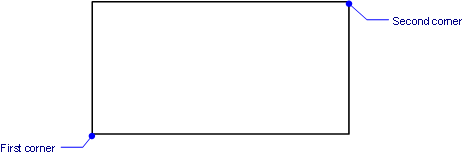
Rectangles are made from polylines.
You can combine options, such as creating a rotated rectangle with width and filleted corners:
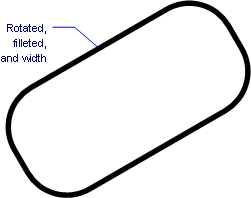
Command Options
|
Option |
Description |
|
Specifies the first corner of the rectangle. |
|
|
Specifies the opposite corner of the rectangle. |
|
|
Applies a chamfer to all four corners of the rectangle. When chamfer distances = 0, prompts you: Defaults/First chamfer distance to use for all rectangles - enter an option. When chamfer distances are not 0, prompts you: Off/Defaults/First chamfer distance to use for all rectangles - enter an option.
The same chamfer is applied to all four corners. You can specify chamfer distances only; you cannot specify a chamfer angle. You can also edit the chamfers later with the Chamfer command. |
|
|
Off |
Turns off chamfering; uses 0 as the chamfer distances. |
|
Defaults |
Uses the default chamfer distances as stored by the Rectang command. This command does not use the ChamferA and ChamferB system variables. |
|
First chamfer distance to use for all rectangles |
Specifies the first chamfer distance; enter 0 or a positive number.
|
|
Second chamfer distance to use for all rectangles |
Specifies the other chamfer distance; enter 0 or a positive number. |
|
|
|
|
Specifies the elevation of the rectangle; prompts you: Elevation to use for all rectangles - specify the elevation; enter a positive or negative number. The elevation is the height above or below the x,y-plane. See Elev command. |
|
|
Applies a fillet radius to all four corners. When fillet radius = 0, prompts you: Fillet distance to use for all rectangles - specify the fillet radius; enter 0 or a positive number. When fillet radius not 0, prompts you: Off/Default/Fillet distance to use for rectangles - enter an option.
The same fillet is applied to all four corners. Caution: when the fillet radius is larger than the rectangle, an invisible rectangle is drawn. See Fillet command. |
|
|
Off |
Turns off filleting; uses 0 as the fillet radius. |
|
Default |
Uses the default fillet radius as stored by the Rectang command. This command does not use the FilletRad system variable. |
|
Fillet distance to use for rectangles |
Specifies the fillet radius; enter 0 or a positive number. |
|
|
|
|
Rotates the rectangle; delays the prompt until after the 'Other corner of rectangle' prompt: Rotation angle for rectangle - specify the rotation angle; pick a point or enter an angle.
Positive angles are measured counter-clockwise from the positive x axis. See Rotate command. |
|
|
Draws a square; delays the prompt until after the 'Select first corner of rectangle' prompt: Second corner of square - specify the opposite corner; pick a point, or enter x,y coordinates.
See Polygon command. |
|
|
Specifies the thickness of the rectangle. When thickness = 0, prompts you: Rectangle thickness - specify the thickness; enter 0 or a positive number. When fillet radius not 0, prompts you: Default/Rectangle thickness - enter an option.
The thickness is the height of the rectangle in the z direction; it is measured upwards from the elevation. See Elev command. |
|
|
Default |
Uses the default thickness as stored by the Rectang command. This command does not use the Thickness system variable. |
|
Rectangle thickness |
Specifies the thickness; enter 0 or a positive number. |
|
|
|
|
|
Specifies the width of the rectangle's lines; prompts you: Width to use for all rectangles - enter 0 or a positive number.
The width is applied equally to all four segments making up the rectangle. For tapered widths, edit the rectangle with the PEdit command. |
|
|
|
|
Specifies the area of the rectangle prompts you: Enter Area of rectangle <current value>: enter a non-zero value or press enter to accept the current value Calculate rectangle dimensions based on [Length/Width]<Length>: enter L or W Enter rectangle length <current
value>: enter a non-zero value |
|
|
|
|
|
Specifies the dimensions of the rectangle prompts you: Length to use for rectangles <current value>: enter a non-zero value or press enter to accept the current value or specify the length of the rectangle by clicking two points. Width to use for rectangles <current value>: enter a non-zero value or press enter to accept the current value or specify the width of the rectangle by clicking two points. |
|
Procedures
Grips Editing
Rectangles can be edited directly through grips:
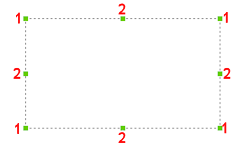
Select the rectangle. Notice that it has one grip at each vertex (1) and one grip at the midpoint of each side (2).
Press and hold the Shift key to select multiple vertices.
Drag a vertex grip (1) to stretch the vertex.
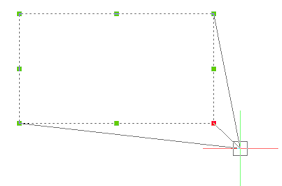
Drag a side grip (2) to stretch the side segment.
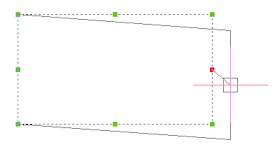
Related Commands
PLine - draws polyline segments and arcs.
3dPoly - draws polylines with x,y,z coordinates.
Polygon - draws regular polygons out of polylines.
Donut - draws wide circles from polylines.
PEdit - edits polylines.
| © Menhirs NV. All rights reserved. |